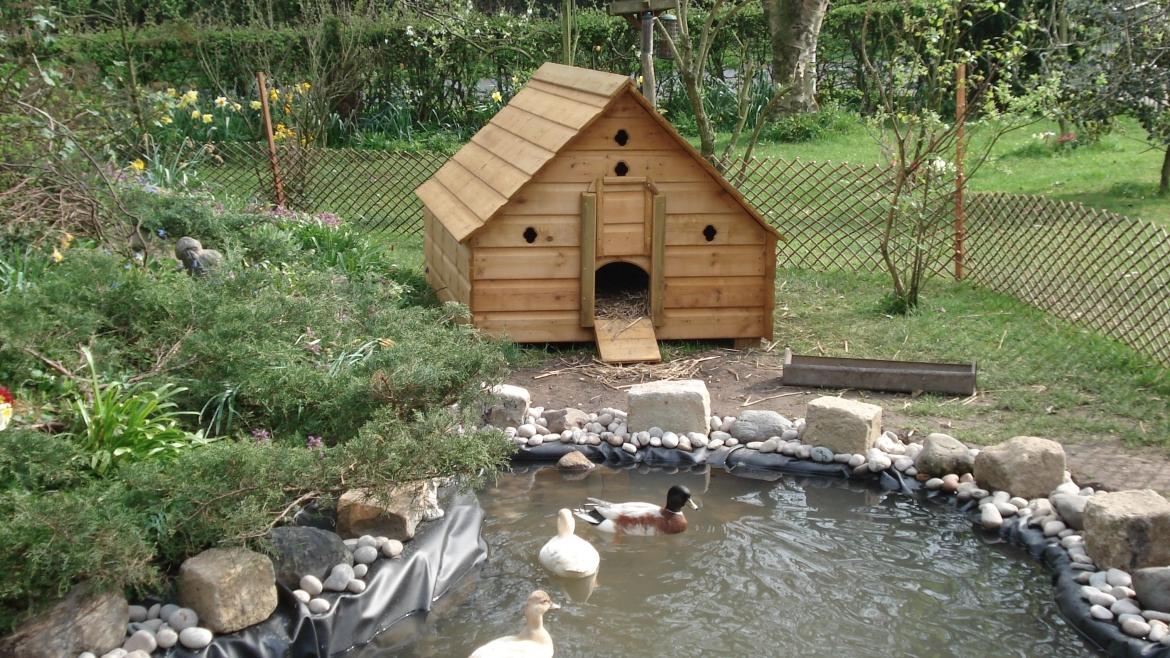(Podcast Episode)
How To Build A Small Duck Pond
Are you a duck lover looking for a new project to take on? Or do you have a backyard with enough space to create a peaceful and natural dynamic environment?
Building a duck pond may be the perfect solution for you! A duck pond can provide a beautiful and relaxing oasis in your backyard with its calming waters, natural fauna, and soft quacks.
In this blog post, we’ll guide you through building a natural and balanced duck pond that is easy to maintain. Whether you’re a seasoned DIYer or a beginner, this project will bring joy and beauty to your backyard. So, let’s dive in!

Step 1: Plan and Prepare
Before building your duck pond, you must have a plan. Here are some things to consider:
- Location: Choose a spot in your backyard that is level and gets plenty of sunlight. Avoid areas with overhanging trees or near a busy road.
- Size: Decide on the size of your pond depending on the number of ducks you plan to keep. A great rule of thumb is to have 10 square feet of water surface area for each duck.
- Depth: The pond should be at least 2-3 feet deep to provide enough space for ducks to swim and dive.
- Materials: For a natural-looking pond, use rocks, gravel, and sand to line the pond. You can also add aquatic plants to cover and food for the ducks.
Step 2: Build the Pond
Once you plan, it’s time to build the duck pond. Here are the steps:
- Dig the hole: Dig a hole in the chosen location that is the desired size and depth.
- Line the pond: Line the bottom of the pond with rocks, gravel, and sand to create a natural-looking base. You can also add a liner to prevent water from seeping into the ground.
- Add water: Fill the pond with water and let it stay for a few days to allow the water to settle.
- Add aquatic plants: Once the water has settled, add aquatic plants like water lilies and duckweed to provide cover and food for the ducks.

Step 3: Maintain the Pond
Maintaining your duck pond is essential to keep it healthy for your ducks. These are some tips and tricks to keep your pond clean:
- Using a skimmer net removes debris like leaves and twigs from the water.
- Add straw or barley straw to the pond to help balance the water chemistry and prevent algae growth.
- Change the water periodically to avoid stagnant water and buildup of harmful bacteria.
Step 4: Consider Adding Fish
If you want to add more life to your duck pond, consider adding fish. Some fishes, such as Koi and Goldfish, are great for adding color and activity to the pond. However, remember that some fish species may not coexist well with ducks, so be sure to research before adding them to the pond.

Step 5: Provide Shelter
Ducks need a place to rest and shelter from the elements. You can provide them with a small cover or nesting box near the pond. You should place the body where it is easily accessible to the ducks and away from predators.
Step 6: Create a Natural Environment
To make your duck pond look more natural, you can add some natural elements like rocks, logs, and sticks around the pond. These elements provide cover for the ducks and create a more natural environment. You can also add native plants around the pond to attract other fauna like insects and birds.
Step 7: Ensure Proper Drainage
Proper drainage is essential to keep your duck pond clean and healthy. You should ensure an appropriate drainage system to prevent water from stagnating and becoming a breeding ground for harmful bacteria. Consider installing a small pump or filter system to keep the water clean and clear.

Step 8: Monitor the Pond
Regular pond monitoring is crucial to ensure the health and safety of your ducks. Check the water quality regularly and adjust the chemical balance if necessary. Look for any signs of sickness or disease in your ducks and take immediate action if needed.
Step 9: Add Straw
Adding straw to your duck pond can help keep the water clean by absorbing extra nutrients and preventing algae growth. Add a bale of straw to the pond and let it float on the surface. The straw will gradually decompose, releasing enzymes that break down the organic matter and create a more natural balance in the pond.
Step 10: Use Natural Pond Cleaners
To keep your duck pond clean and healthy, avoid using toxic chemicals that can harm the environment and your ducks. Instead, consider using natural pond cleaners like barley straw or beneficial bacteria. These natural products can help break down organic matter and prevent the growth of harmful bacteria and algae.

Step 11: Consider Hunting Regulations
If you plan on using your duck pond for hunting, it’s essential to familiarize yourself with local hunting regulations. Ensure you have the proper licenses and permits, and follow all safety guidelines when hunting near the pond. Also, consider creating a designated hunting area away from the main pond to ensure the safety of your ducks and other wildlife.
Step 12: Enjoy Your Duck Pond
Once your duck pond is complete, take the time to enjoy it! Please relax, watching the ducks swim and play in their new home. Consider adding a bench or other seating area near the pond to create a peaceful and relaxing space in your backyard. Remember to maintain your pond regularly to ensure your ducks’ and other wildlife’s health and safety. Enjoy your new duck pond’s natural beauty and tranquility.

FAQs
- Can I fill my duck pond with tap water?
You can use tap water to fill your duck pond. However, tap water may contain chlorine or other chemicals that can harm your ducks and other wildlife. To ensure the safety of your ducks, you should treat the water with a de-chlorinator or let the water sit for a few days to allow the chlorine to dissipate before adding your ducks.
- Do I need to provide food for my ducks in the pond?
Ducks are omnivorous and will feed on various foods, including insects, snails, and aquatic plants. However, you can also provide supplemental food like cracked corn or duck feed to ensure your ducks get enough nutrition. It’s essential to avoid overfeeding, as this can lead to water pollution and health problems for your ducks. Consult with a veterinarian or wildlife expert for advice on the appropriate feeding regimen for your ducks.
Final Verdict
Building a small duck pond can be a fun and rewarding project that benefits your feathered friends and adds natural beauty and tranquility to your backyard. Following the steps mentioned in this blog post and properly maintaining your pond, you can create a thriving ecosystem that provides shelter, food, and a natural habitat for ducks and other waterfowl.
Remember always to consider the size and location of your pond, provide adequate shelter and natural elements, and monitor the water quality to ensure the health and safety of your ducks. So, what are you waiting for? Grab your tools and roll up your sleeves, and start building your natural and beautiful duck pond today!


